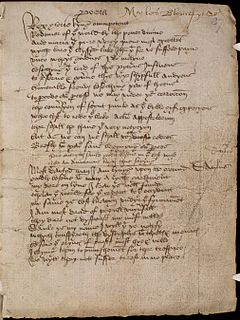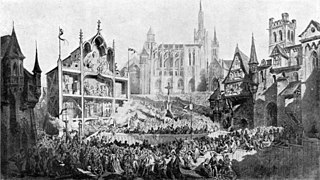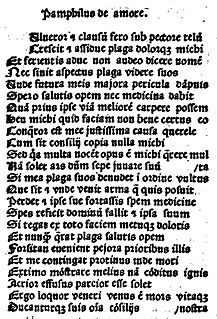 W
WMedieval theatre encompasses theatrical performance in the period between the fall of the Western Roman Empire in the 5th century and the beginning of the Renaissance in approximately the 15th century. The category of "medieval theatre" is vast, covering dramatic performance in Europe over a thousand-year period. A broad spectrum of genres needs to be considered, including mystery plays, morality plays, farces and masques. The themes were almost always religious. The most famous examples are the English cycle dramas, the York Mystery Plays, the Chester Mystery Plays, the Wakefield Mystery Plays, and the N-Town Plays, as well as the morality play known as Everyman. One of the first surviving secular plays in English is The Interlude of the Student and the Girl.
 W
WAutos sacramentales are a form of dramatic literature which is unique to Spain, though in some respects similar in character to the old Morality plays of England.
 W
WBeunans Meriasek is a Cornish play completed in 1504. Its subject is the legends of the life of Saint Meriasek or Meriadoc, patron saint of Camborne, whose veneration was popular in Cornwall, Brittany, and elsewhere. It was written in the Cornish language, probably written around the same time and in the same place as Bewnans Ke, the only other extant Cornish play taking a saint's life as its subject.
 W
WBewnans Ke is a Middle Cornish play on the life of Saint Kea or Ke, who was venerated in Cornwall, Brittany and elsewhere. It was written around 1500 but survives only in an incomplete manuscript from the second half of the 16th century. The play was entirely unknown until 2000, when it was identified among the private collection of J. E. Caerwyn Williams, which had been donated to the National Library of Wales after his death the previous year. The discovery proved one of the most significant finds in the study of Cornish literature and language.
 W
WHubert Cailleau, was a French historical and miniature painter and stage designer, who flourished at Valenciennes. There are some clever designs made by him, that now reside in the National Library at Paris, which were done for a mystery of the Passion acted at Valenciennes in 1547. He is famous for the illustrations of these sets, especially the frontispiece to The Passion and Resurrection of the Savior (1577), which are the most detailed surviving examples of such staging.
 W
WThe Castle of Perseverance is a c. 15th-century morality play and the earliest known full-length vernacular play in existence. Along with Mankind and Wisdom, The Castle of Perseverance is preserved in the Macro Manuscript that is now housed in the Folger Shakespeare Library in Washington, D.C. The Castle of Perseverance contains nearly all of the themes found in other morality plays, but it is especially important because a stage drawing is included, which may suggest theatre in the round.
 W
WThe Cavalcade of the Magi is a traditional parade with floats carrying the wise men taking place in practically all Spanish cities and villages, in Andorra and Argentina, in some cities and towns in Mexico and Gibraltar. The Magi ride through the streets, as their pages collect children's letters to the kings and also throw candy to children. The cavalcade usually includes dancers, musicians, and pages, as well as other assistants to the kings.
 W
WThe Chester Mystery Plays is a cycle of mystery plays originating in the city of Chester, England and dating back to at least the early part of the 15th century.
 W
WThe Coventry Mystery Plays, or Coventry Corpus Christi Pageants, are a cycle of medieval mystery plays from Coventry, West Midlands, England, and are perhaps best known as the source of the "Coventry Carol". Two plays from the original cycle are extant having been copied from the now lost original manuscript in the early 19th century. Another, separate manuscript was initially titled the Ludus Coventriae by a 17th-century librarian who erroneously assumed it was copy of the Coventry mystery plays. The collection within this manuscript are now more commonly known as the N-Town Plays and are thought to have originated in East Anglia.
 W
WThe Croxton Play of the Sacrament is the only surviving English Host miracle play. The play centers around the abduction of a Host by a group of Jewish men, and the series of miracles that lead to their conversion of Christianity.
 W
WThe Digby Conversion of Saint Paul is a Middle English miracle play of the late fifteenth century. Written in rhyme royal, it is about the conversion of Paul the Apostle. It is part of a collection of mystery plays that was bequeathed to the Bodleian Library by Sir Kenelm Digby in 1634.
 W
WAn Easter Drama is a liturgical drama or religious theatrical performance in the Roman Catholic tradition, largely limited to the Middle Ages. These performances evolved from celebrations of the liturgy to incorporate later dramatic and secular elements, and came to be performed in local languages. They were succeeded by the Passion Plays.
 W
WLa Farce de maître Pathelin is a fifteenth-century (1457) anonymous medieval farce written originally in French. It was extraordinarily popular in its day, and held an influence on popular theatre for over a century. Its echoes can be seen in the works of Rabelais. A number of phrases from the play became proverbs in French, and the phrase "Let us return to our muttons" even became a common English calque.
 W
WThe Fleury Playbook is a medieval collection of Latin biblical dramas dating from around 1200 AD It was included in a composite volume of sermons, biblical texts, liturgical dramas, and hymns that was bound and kept at the library of Abbaye Saint Benoît de Fleury, a Benedictine monastery at Saint-Benoît-sur-Loire, France, until after the French Revolution and is now housed in the Bibliothèque de la Ville at Orléans, France. The works in the playbook are told in a musical style similar to that of plainsong. The origin of the book is unknown, but it is possible that it was written by multiple authors. The playbook consists of a total of 10 works, occupying pages 176–243 of the manuscript.
 W
WFolly was a common allegorical figure in medieval morality plays and in allegorical artwork through the Renaissance. The depiction is generally of a young man, often similar in appearance to a jester or the tarot card, The Fool. In contrast to the many obvious classical allusions in such works, the depictions owe little to the Greek goddess Atë.
 W
WHildegard of Bingen, also known as Saint Hildegard and the Sibyl of the Rhine, was a German Benedictine abbess and polymath active as a writer, composer, philosopher, mystic, visionary, and as a medical writer and practitioner during the High Middle Ages. She is one of the best-known composers of sacred monophony, as well as the most recorded in modern history. She has been considered by many in Europe to be the founder of scientific natural history in Germany.
 W
WHorestes is a late Tudor morality play by the English dramatist John Pickering. It was first published in 1567 and was most likely performed by Lord Rich's men as part of the Christmas revels at court that year. The play's full title is A new interlude of Vice containing the history of Horestes with the cruel revengement of his father's death upon his one natural mother. It has been proposed that John Pickering is likely to be the same person as lawyer and politician Sir John Puckering.
 W
WLiturgical drama refers to medieval forms of dramatic performance that use stories from the Bible or Christian hagiography.
 W
WThe Macro Manuscript is a collection of three 15th-century English morality plays, known as the "Macro plays" or "Macro moralities": Mankind, The Castle of Perseverance, and Wisdom. So named for its 18th-century owner Reverend Cox Macro (1683–1767), the manuscript contains the earliest complete examples of English morality plays. A stage plan attached to The Castle of Perseverance is also the earliest known staging diagram in England. The manuscript is the only source for The Castle of Perseverance and Mankind and the only complete source for Wisdom. The Macro Manuscript is a part of the collection at the Folger Shakespeare Library in Washington, D.C.. For centuries, scholars have studied the Macro Manuscript for insights into medieval drama. As Clifford Davidson writes in Visualizing the Moral Life, "in spite of the fact that the plays in the manuscript are neither written by a single scribe nor even attributed to a single date, they collectively provide our most important source for understanding the fifteenth century English morality play."
 W
WMankind is an English medieval morality play, written c. 1470. The play is a moral allegory about Mankind, a representative of the human race, and follows his fall into sin and his repentance. Its author is unknown; the manuscript is signed by a monk named Hyngham, believed to have transcribed the play. Mankind is unique among moralities for its surprising juxtaposition of serious theological matters and colloquial dialogue. Along with the morality plays Wisdom and The Castle of Perseverance, Mankind belongs to the collection of the Folger Shakespeare Library in Washington, D.C. as a part of the Macro Manuscript.
 W
WLe Miracle de Théophile is a thirteenth-century miracle play written in Langues d'oïl, circa 1261 by the trouvère Rutebeuf.
 W
WThe Misterio de Elche, in English the Mystery Play of Elche or Elche Mystery Play and in Catalan Misteri d'Elx, is a liturgical drama from the Middle Ages that reenacts the Dormition and Assumption of the Blessed Virgin Mary.
 W
WThe morality play is a genre of medieval and early Tudor drama. Morality plays, at least as the term is used by scholars of literary and dramatic history, refers to a genre of play texts from the fourteenth through sixteenth centuries that feature personified concepts alongside angels and demons, who are engaged in a struggle to persuade a protagonist who represents a generic human character toward either good or evil. The common story arc of these plays follows “the temptation, fall and redemption of the protagonist.”
 W
WMystery plays and miracle plays are among the earliest formally developed plays in medieval Europe. Medieval mystery plays focused on the representation of Bible stories in churches as tableaux with accompanying antiphonal song. They told of subjects such as the Creation, Adam and Eve, the murder of Abel, and the Last Judgment. Often they were performed together in cycles which could last for days. The name derives from mystery used in its sense of miracle, but an occasionally quoted derivation is from ministerium, meaning craft, and so the 'mysteries' or plays performed by the craft guilds.
 W
WThe Ordinalia are three medieval mystery plays dating to the late fourteenth century, written primarily in Middle Cornish, with stage directions in Latin. The three plays are Origo Mundi, Passio Christi and Resurrexio Domini. The metres of these plays are various arrangements of seven- and four-syllabled lines. Ordinalia means "prompt" or "service book".
 W
WThe Ordo Rachelis, Interfectio Puerorum, or Ludus Innocentium is a medieval dramatic tradition consisting in four plays and based on the Massacre of the Innocents, an event recorded in the Gospel of Matthew, and on the prophecy recorded in the Book of Jeremiah: "A voice was heard in Ramah, lamentation, and bitter weeping; Rahel weeping for her children refused to be comforted for her children, because they were not". The prophecy, which Matthew believed to be fulfilled when Herod the Great ordered the slaughter of all boys under two in Bethlehem, looks backwards to Rachel, the matriarch of the Hebrews, and towards her lamentation over the death of her children, the Hebrew children, in the massacre.
 W
WPamphilus de amore is a 780-line, 12th-century Latin comedic play, probably composed in France, but possibly Spain. It was "one of the most influential and important of the many pseudo-Ovidian productions concerning the 'arts of Love'" in medieval Europe, and "the most famous and influential of the medieval elegiac comedies, especially in Spain". The protagonists are Pamphilus and Galatea, with Pamphilus seeking to woo her through a procuress.
 W
WThe Passion Play or Easter pageant is a dramatic presentation depicting the Passion of Jesus Christ: his trial, suffering and death. It is a traditional part of Lent in several Christian denominations, particularly in Catholic tradition.
 W
WA Satire of the Three Estates, is a satirical morality play in Middle Scots, written by makar Sir David Lyndsay. The complete play was first performed outside in the playing field at Cupar, Fife in June 1552 during the Midsummer holiday, where the action took place under Castle Hill. It was subsequently performed in Edinburgh, also outdoors, in 1554. The full text was first printed in 1602 and extracts were copied into the Bannatyne Manuscript. The Satire is an attack on the Three Estates represented in the Parliament of Scotland – the clergy, lords and burgh representatives, symbolised by the characters Spiritualitie, Temporalitie and Merchant. The clergy come in for the strongest criticism. The work portrays the social tensions present at this pivotal moment in Scottish history.
 W
WThe Second Shepherds' Play is a famous medieval mystery play which is contained in the manuscript HM1, the unique manuscript of the Wakefield Cycle. These plays are also referred to as the Towneley Plays, on account of the manuscript residing at Towneley Hall. The plays within the manuscript roughly follow the chronology of the Bible and so were believed to be a cycle, which is now considered not to be the case. This play gained its name because in the manuscript it immediately follows another nativity play involving the shepherds. In fact, it has been hypothesized that the second play is a revision of the first. It appears that the two shepherd plays were not intended to be performed together since many of the themes and ideas of the first play carry over to the second one. In both plays it becomes clear that Christ is coming to Earth to redeem the world from its sins. Although the underlying tone of The Second Shepherd's Play is serious, many of the antics that occur among the shepherds are extremely farcical in nature.
 W
WStar singers also known as Epiphany singers, or Star boys' singing procession (England), are children and young people walking from house to house with a star on a rod and often wearing crowns and dressed in clothes to resemble the Three Magi. The singing processions have their roots in an old medieval ecclesiastical play, centred on the Biblical Magi of the Christmas story in the Gospel of Matthew, appropriate to Epiphany. It is observed usually during the period between 27 December and 6 January.
 W
WA tableau vivant, French for "living picture", is a static scene containing one or more actors or models. They are stationary and silent, usually in costume, carefully posed, with props and/or scenery, and may be theatrically lit. It thus combines aspects of theatre and the visual arts.
 W
WWisdom is one of the earliest surviving medieval morality plays. Together with Mankind and The Castle of Perseverance, it forms a collection of early English moralities called "The Macro Plays". Wisdom enacts the struggle between good and evil; as an allegory, it depicts Christ and Lucifer battling over the Soul of Man, with Christ and goodness ultimately victorious. Dating between 1460-1463, the play is preserved in its complete form in the Macro Manuscript, currently a part of the collection of the Folger Shakespeare Library. A manuscript fragment of the first 754 lines also belongs to the Bodleian Library. Although the author of Wisdom remains anonymous, the manuscript was transcribed and signed by a monk named Thomas Hyngman. Some scholars have suggested that Hyngman also authored the play.
 W
WThe World and the Child is an anonymous English morality play. Its source is a late 14th-century or 15th-century poem The Mirror of the Periods of Man's Life, from which the play borrows significantly while reducing the number of characters. It is thought to have influenced William Shakespeare's Henry IV, Part 1.
 W
WThe York Mystery Plays, more properly the York Corpus Christi Plays, are a Middle English cycle of 48 mystery plays or pageants covering sacred history from the creation to the Last Judgment. They were traditionally presented on the feast day of Corpus Christi and were performed in the city of York, from the mid-fourteenth century until their suppression in 1569. The plays are one of four virtually complete surviving English mystery play cycles, along with the Chester Mystery Plays, the Towneley/Wakefield plays and the N-Town plays. Two long, composite, and late mystery pageants have survived from the Coventry cycle and there are records and fragments from other similar productions that took place elsewhere. A manuscript of the plays, probably dating from between 1463 and 1477, is still intact and stored at the British Library.